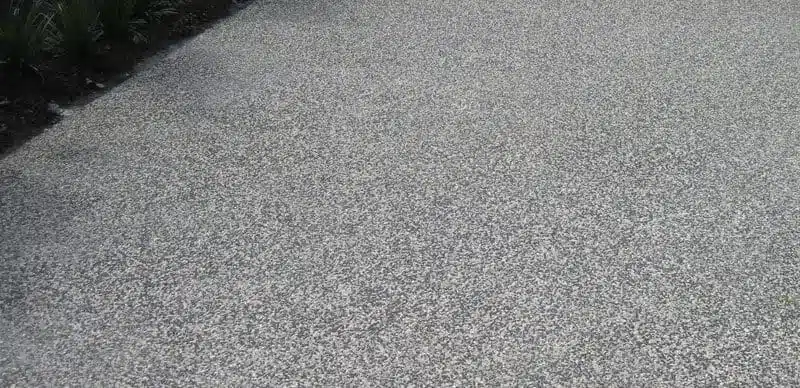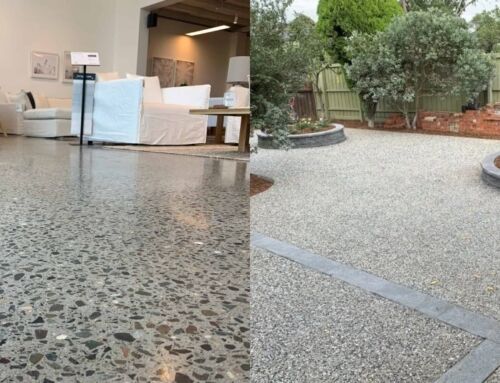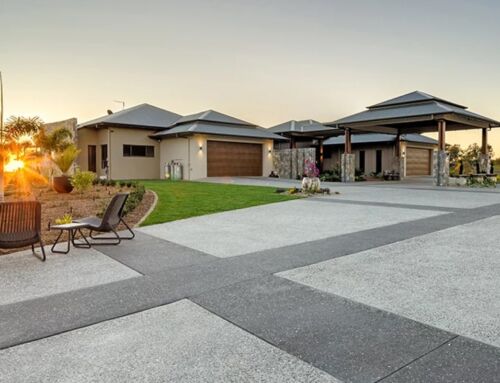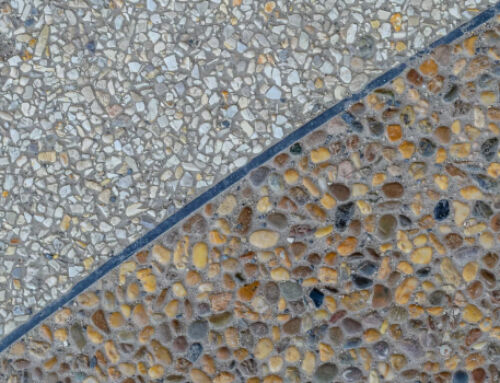Exposed aggregate concrete is as durable as plain concrete and more durable than natural stone. But this modern, stylish concrete finish does pose one tricky question – which surface will you choose? With a range of colours, styles, sizes, and shapes on offer, read on to compare your options and find the aggregate that’s best for you.
When it comes to a home improvement project, a new concrete surface isn’t typically thought of as offering endless design options.
But this type of concrete isn’t your average concrete surface.
Created by exposing the internal aggregate (whether natural or added) as part of your concrete’s final surface, your design options are many. And since ‘aggregate’ is a fancy way of describing the course materials used in construction, this covers a broad range of resources including rocks, sand, pebbles, granite, bluestone or riverstone, and much more.
If you’re looking to update your tired concrete surfaces, or pour a new concrete driveway, pathway, or garage floor, read on to compare the most common aggregate options and find a finish that suits your taste, needs, and budget.
Concept Concrete specialises in the removal or replacement of concrete. We don’t offer repair and resurfacing services. Sorry for any inconvenience.
If you want to learn more about exposed aggregate concrete, check out our resources:
1. How Much Does Exposed Aggregate Concrete Cost
2. Plain Concrete vs. Exposed Aggregate: How to Settle the Debate
3. Exposed Aggregate vs. Stamped Concrete: What’s Best For You?
4. Is Exposed Aggregate Concrete Worth It?
5. How Long Will Exposed Aggregate Last?
What is exposed aggregate concrete?
Before we start comparing the options, let’s quickly recap what this concrete finish is and why it’s so popular in Australian homes.
Long gone are the days when concrete was dull and for practical purposes only. Modern concrete – from driveways to garages and pathways – comes in a variety of decorative finishes. Exposed aggregate concrete is a type of decorative concrete created with a paved concrete base with an exposed top layer.
This exposed layer of aggregate (hence the name exposed aggregate concrete can be natural or manufactured with a range of natural stones and durable materials added to customise your surface to suit your home’s style.
Common aggregate options include:
-
Basalt
- Granite
- Quartz
- Riverstone
- Gravel
- Crushed stone
- Natural sand
- Blue stone
- And much, much more.
Clearly, there are countless options when it comes to your concrete finish, and we’ll explore them for you right now.
Unsure which decorative concrete is right for you? Click here for our ultimate comparison between exposed aggregate and stamped concrete
How to create this type of concrete finish
Choosing the best aggregate for your concrete requires an understanding of how this concrete is poured and finished. For example, if your flooring team is laying standard exposed aggregate concrete, you’ll be limited by the random aggregate mixed into your concrete.
To help you understand your options, here are the 3 common ways to lay concrete.
Standard Aggregate
All concrete contains natural aggregate that’s been mixed into the concrete batch. This is the simplest way to choose an exposed aggregate finish but it means you’ll need to be happy with the random placement and mixture of aggregate with less control over your finish. This aggregate is most likely to be unconsolidated sand, gravel, or rock.
Topping Aggregate
Topping aggregate offers more control than the standard exposed aggregate. This is done by pouring a concrete slab, with an additional top layer (or topping concrete) poured once the slab is dry. This top layer is typically 1 and ½ to 2 inches thick. By filling this topping layer with the aggregate of your choice, you have more control over your finish.
Seeded Aggregate
Seeded aggregate offers the most control over your concrete finish. This is achieved by placing (or seeding) aggregate into the surface of wet concrete at the time of placement, allowing the most creative control over how your concrete looks. Keep in mind, this is the most labour-intensive approach.
Looking to price your next concrete project? Click here for our ‘Exposed Aggregate Concrete Price Guide [2022 Edition]’
Factors to take into account when choosing your exposed aggregate finish
Now you know how exposed aggregate concrete is created, let’s cover some of the primary considerations you’ll need to take into account.
Failure to think about these pre-requisites before you start a home improvement project can leave you with a concrete surface that doesn’t match your style. Or worse, a concrete surface that isn’t able to handle your foot and vehicle traffic.
Colour
The best exposed aggregate concrete will meet your colour preferences, and the colour of your surface will come down to the stone you choose. Many natural stones offer unique colour schemes that can be used to complement your home, garage, or garden.
Some of the most popular options include delicate pastel colours like pink or rose quartz. As well as rich, striking colours in the form of dark blue or red granite. Many homeowners also prefer earthy tones that suit the great outdoors with sandy brown river stones, grey limestone, or black basalt offering rustic and grounding colours.
Concept Concrete Tip: Keep in mind that aggregate is only part of the visual effect. You can also decide if you want to complement your choice of aggregate with coloured concrete oxide base for a more eye-grabbing finish.
Size & Shape
The best exposed aggregate concrete for you will also need to take into account the needs of your surface. Sizes range from ⅜ of an inch to 2 inches or more in diameter. The size and shape are more than an aesthetic choice, as they will directly impact the durability and optimal usage of your newly laid concrete surface.
Rounded aggregate options provide the best coverage with a smoother surface that suits bare feet and heavy foot traffic. In contrast, the angular aggregate may not be as comfortable but adds texture and dimension.
Concept Concrete Tip: Avoid flat aggregate pieces. While these may seem suited to foot traffic and vehicle traffic, they are also easily dislodged and can leave you needing constant repairs that become an expensive frustration over time.
Texture
You’ve found a colour and shape/size you love? You’re off to a great start, but don’t go out and pull the trigger on a new concrete surface just yet.
The best exposed aggregate surface will also take into account your usage needs, and that comes down to the texture of the material you opt for. The easiest way to find the best texture is to ask yourself a few important questions:
- Is your concrete surface mainly used for vehicle traffic?
- Will you be walking on the concrete surface often?
- Will your surface need a drainage solution during Melbourne’s rainy days?
If you want to walk on your aggregate, it’s best to choose a fine aggregate that promotes comfort. But if you plan on parking the family car outside on your new concrete surface, you may need to look at a coarser aggregate mix to help spread water and prevent skidding.
Looking for help choosing the right solution for your home?
Offering texture and grip, exposed aggregate concrete offers the same durability as plain concrete, but can handle heavy traffic (whether it’s a busy family BBQ or the family car) year after year with minimal maintenance required.
With a more “natural” look than brick or plain concrete, you also enjoy advanced durability over a natural stone without sacrificing the natural earthy look you love.
But choosing the right aggregate can quickly become a chore. Between Google searches, requesting samples from local suppliers, and asking friends for tips, it doesn’t take much to feel overwhelmed with options.
Feeling overwhelmed by choice? We understand it’s tough to make a choice between the many types of aggregate on offer, so let’s start with an obligation-free chat and go from there.






